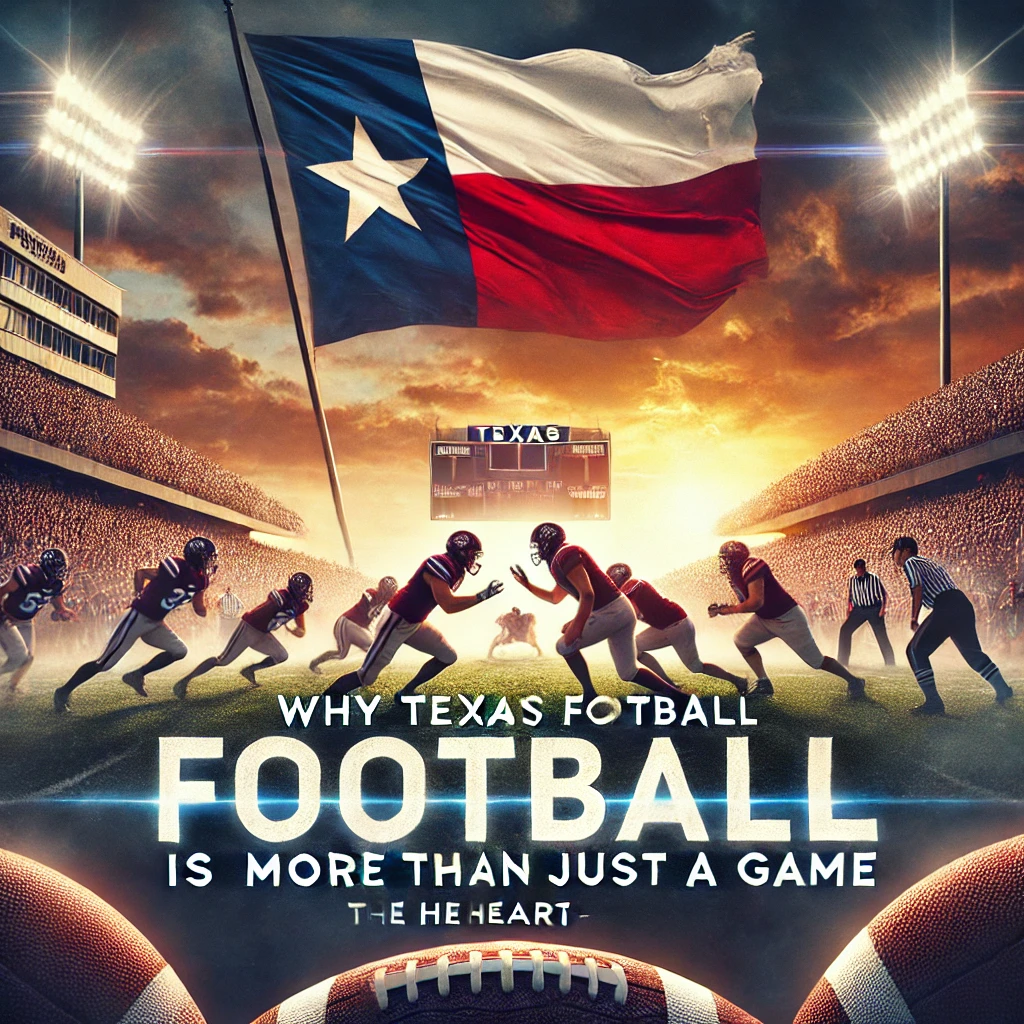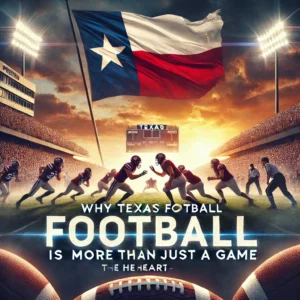"Why Texas Football is More Than Just a Game | The Heart "

Texas Football: A Deep Dive into the Culture, History, and Passion of the Lone Star State
Texas football is more than just a game; it’s a way of life. From high school fields to college stadiums and even the professional ranks, football in Texas is woven into the cultural fabric of the state. The pride, dedication, and fierce competition that define Texas football have created a legacy that spans generations. Whether you’re cheering for the Friday night lights in a small town or packing into a massive stadium for a University of Texas game, the sport embodies the essence of community, tradition, and excellence in the Lone Star State.
The Roots of Texas Football
Football in Texas has its roots in the late 19th century, when the sport began to emerge as a popular activity in schools and colleges across the state. However, it wasn’t until the early 20th century that the game really took hold, becoming a central feature of Texas culture. High school football, in particular, became a point of pride for many communities, where local teams often symbolized more than just athletic talent—they represented the hopes, dreams, and values of the towns they represented.
One of the most significant early milestones in Texas football history occurred in 1893, when the University of Texas at Austin played its first intercollegiate football game. This set the stage for the rise of college football, which would soon become a key component of Texas sports culture. By the 1920s and 1930s, football in Texas was booming, with high school teams drawing thousands of fans and college teams beginning to establish themselves on the national stage.
High School Football: The Heart and Soul of Texas
If college and professional football are the pinnacles of the sport, high school football is the heart and soul of Texas. High school football in Texas is more than just a game—it’s an event, a community gathering, and in many cases, a matter of pride and identity. Small towns and big cities alike rally behind their teams, and for many communities, the success of the local high school football team is a reflection of their own success.
Texas high school football is governed by the University Interscholastic League (UIL), which oversees a variety of sports and academic competitions across the state. The UIL organizes football competitions into different divisions based on school size, ensuring that schools of similar enrollment compete against each other. This system helps maintain a level playing field and ensures that the state’s best teams rise to the top.
The passion for high school football in Texas is perhaps best exemplified by the sheer size of the crowds. Some high school stadiums in Texas rival the size of small college venues, with thousands of fans packing in to watch their teams play. Towns often shut down on Friday nights during football season, with local businesses closing early so everyone can attend the game. For many Texans, Friday night football is a family tradition passed down through generations.

Legendary Programs and Coaches
Texas has produced some of the most storied high school football programs in the nation. Schools like Katy, Southlake Carroll, Allen, and Odessa Permian have become synonymous with success, regularly competing for state championships and producing top-tier talent. These programs have earned national recognition for their dominance on the field and their ability to produce college and NFL players.
One of the most famous high school football programs in Texas history is Odessa Permian, which gained national attention through the book “Friday Night Lights,” written by H.G. Bissinger in 1990. The book, which was later adapted into a movie and television series, chronicles the 1988 season of the Odessa Permian Panthers and explores the pressures and expectations placed on high school athletes in Texas. The story captured the intensity and passion of Texas high school football and solidified Odessa Permian’s place in football lore.
The state has also been home to legendary high school coaches, such as Todd Dodge, who led Southlake Carroll to four state championships in the 2000s, and Gary Joseph, who turned Katy High School into a powerhouse, winning multiple state titles. These coaches are revered not only for their success on the field but also for the impact they have had on the lives of their players, many of whom have gone on to achieve great things both on and off the field.
College Football: A Lone Star Tradition
Texas is home to some of the most storied college football programs in the country, with schools like the University of Texas at Austin (UT), Texas A&M University, Texas Tech, and Baylor University competing at the highest level of NCAA Division I football. The rivalries, traditions, and history of Texas college football make it a deeply ingrained part of the state’s identity.
**The University of Texas Longhorns** is one of the most iconic college football teams in the nation. With a history that dates back to 1893, the Longhorns have won multiple national championships and boast some of the most passionate fans in the country. Darrell K Royal, one of the most legendary coaches in college football history, led the Longhorns to three national titles and 11 conference championships during his tenure from 1957 to 1976. The “Hook ‘Em Horns” hand sign and the school’s signature burnt orange uniforms are recognized symbols of the team’s fierce competitiveness and pride.
**Texas A&M Aggies**, another giant of Texas football, also boasts a rich history, with a fan base that is as loyal as it is passionate. The Aggies’ famous “12th Man” tradition, where the entire student section stands during games to symbolize their readiness to take the field if needed, is one of the most enduring and unique traditions in college football. The rivalry between Texas A&M and the University of Texas is one of the most intense in the sport, though the two teams have not played each other since Texas A&M moved to the Southeastern Conference (SEC) in 2012.
Other schools like **Baylor University** and **Texas Tech** also have strong football traditions, with their programs consistently competing at a high level. Baylor, in particular, has enjoyed recent success, with the Bears winning two Big 12 championships in the 2010s under head coach Art Briles.
Professional Football: The Dallas Cowboys and Houston Texans
While high school and college football dominate much of the Texas football landscape, the state is also home to two NFL teams: the **Dallas Cowboys** and the **Houston Texans**. The Cowboys, often referred to as “America’s Team,” are one of the most successful and popular franchises in NFL history. With five Super Bowl championships and a fan base that extends far beyond Texas, the Cowboys have become a symbol of football excellence.
Founded in 1960, the Cowboys experienced their greatest success under head coach Tom Landry, who led the team to two Super Bowl titles in the 1970s. The 1990s brought another era of dominance, with quarterback Troy Aikman, running back Emmitt Smith, and wide receiver Michael Irvin forming the backbone of a team that won three Super Bowls in four years under head coach Jimmy Johnson.
The **Houston Texans**, founded in 2002, are the newer of Texas’s two NFL teams. While the Texans have yet to achieve the same level of success as the Cowboys, they have built a strong fan base and have consistently fielded competitive teams. The Texans have produced several standout players, including defensive end J.J. Watt and quarterback Deshaun Watson, and have won multiple AFC South division titles.
The Future of Texas Football
Texas football continues to evolve, with new stars emerging and old traditions persisting. The state’s high school football scene remains as competitive as ever, with more schools investing in state-of-the-art facilities and coaching staffs. College football in Texas is also entering an exciting new era, with the University of Texas joining the SEC and Texas A&M continuing to recruit top-tier talent.
At the professional level, both the Cowboys and Texans have promising futures. The Cowboys, led by quarterback Dak Prescott, remain perennial contenders, while the Texans are in the process of rebuilding with young talent and a new coaching staff.
As the sport continues to grow, one thing remains clear: football in Texas is more than just a game—it’s a passion, a tradition, and a way of life. The state’s football legacy will continue to inspire future generations of players and fans, ensuring that Texas remains at the center of the football world for years to come.
Conclusion
Football in Texas is a microcosm of the state itself—big, bold, and fiercely proud. From high school stadiums to NFL arenas, the sport unites communities, fosters competition, and creates lasting memories for those who participate and spectate. Whether you’re a fan of the Dallas Cowboys, the Texas Longhorns, or your local high school team, football in Texas represents more than just athletic achievement—it represents the enduring spirit of the Lone Star State.
